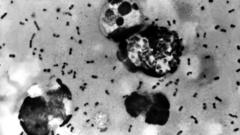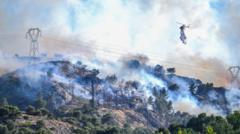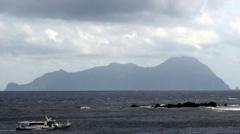Residents in Sarandí, a suburb south of Buenos Aires, were shocked to see a local stream turn bright red, leading to fears of pollution linked to nearby factories. Authorities are investigating the cause, which may involve organic dyes, amid ongoing concerns surrounding chronic industrial waste issues in the region.
Red Stream in Buenos Aires Raises Alarms Over Environmental Pollution

Red Stream in Buenos Aires Raises Alarms Over Environmental Pollution
A stream in Sarandí, Buenos Aires, has turned a disturbing shade of red, alarming residents and environmental experts alike about potential industrial contamination.
The recent transformation of a stream in Sarandí, a neighborhood approximately six miles south of Buenos Aires, has raised serious environmental concerns after it inexplicably turned a vivid red hue. Residents reported being overwhelmed by a strong, unpleasant smell, leading many to suspect that local industries could be responsible for the alarming discoloration.
Local media outlets have detailed testimonies from Sarandí inhabitants, who have long been aware of the pollution issues plaguing the region, attributed to the numerous factories and tanneries operating nearby. Concerns grew as the stream in question feeds into the Río de la Plata, a significant waterway bordered by Argentina and Uruguay. Notably, the Matanza-Riachuelo River basin, part of this ecosystem, has been notorious for its high levels of pollution.
In response to the incident, the environmental ministry for the Province of Buenos Aires announced that officials took water samples for detailed analysis, speculating that the red color might stem from "some type of organic dye." However, results from these tests have not yet been released.
Long-time local resident Maria Ducomls described waking to the stream's unsettling red appearance and its accompanying terrible smell, likening it to a "river covered in blood." She noted that the stream has displayed various unusual colors in the past—including blue, green, and pink—and often bore an oily slick.
Moira Zellner, an academic with a background in environmental policy, called attention to the ingrained pollution problems in the Buenos Aires area, emphasizing the ongoing lack of regulatory enforcement. "It's really heartbreaking," she lamented. "Some of the populations that have settled there are suffering from the consequences."
Carlos Colángelo, president of the Professional Council of Chemistry for the Province of Buenos Aires, echoed this sentiment, expressing concern regarding potential illegal chemical dumping into the stream. "A company that would have dumped this is totally unscrupulous," he asserted, urging the need for accountability and stricter measures to prevent such incidents in the future.
As the community anxiously awaits the water test results, it remains clear that vigilance is crucial in addressing and mitigating the persistent issues of environmental pollution in Buenos Aires.
Local media outlets have detailed testimonies from Sarandí inhabitants, who have long been aware of the pollution issues plaguing the region, attributed to the numerous factories and tanneries operating nearby. Concerns grew as the stream in question feeds into the Río de la Plata, a significant waterway bordered by Argentina and Uruguay. Notably, the Matanza-Riachuelo River basin, part of this ecosystem, has been notorious for its high levels of pollution.
In response to the incident, the environmental ministry for the Province of Buenos Aires announced that officials took water samples for detailed analysis, speculating that the red color might stem from "some type of organic dye." However, results from these tests have not yet been released.
Long-time local resident Maria Ducomls described waking to the stream's unsettling red appearance and its accompanying terrible smell, likening it to a "river covered in blood." She noted that the stream has displayed various unusual colors in the past—including blue, green, and pink—and often bore an oily slick.
Moira Zellner, an academic with a background in environmental policy, called attention to the ingrained pollution problems in the Buenos Aires area, emphasizing the ongoing lack of regulatory enforcement. "It's really heartbreaking," she lamented. "Some of the populations that have settled there are suffering from the consequences."
Carlos Colángelo, president of the Professional Council of Chemistry for the Province of Buenos Aires, echoed this sentiment, expressing concern regarding potential illegal chemical dumping into the stream. "A company that would have dumped this is totally unscrupulous," he asserted, urging the need for accountability and stricter measures to prevent such incidents in the future.
As the community anxiously awaits the water test results, it remains clear that vigilance is crucial in addressing and mitigating the persistent issues of environmental pollution in Buenos Aires.






















